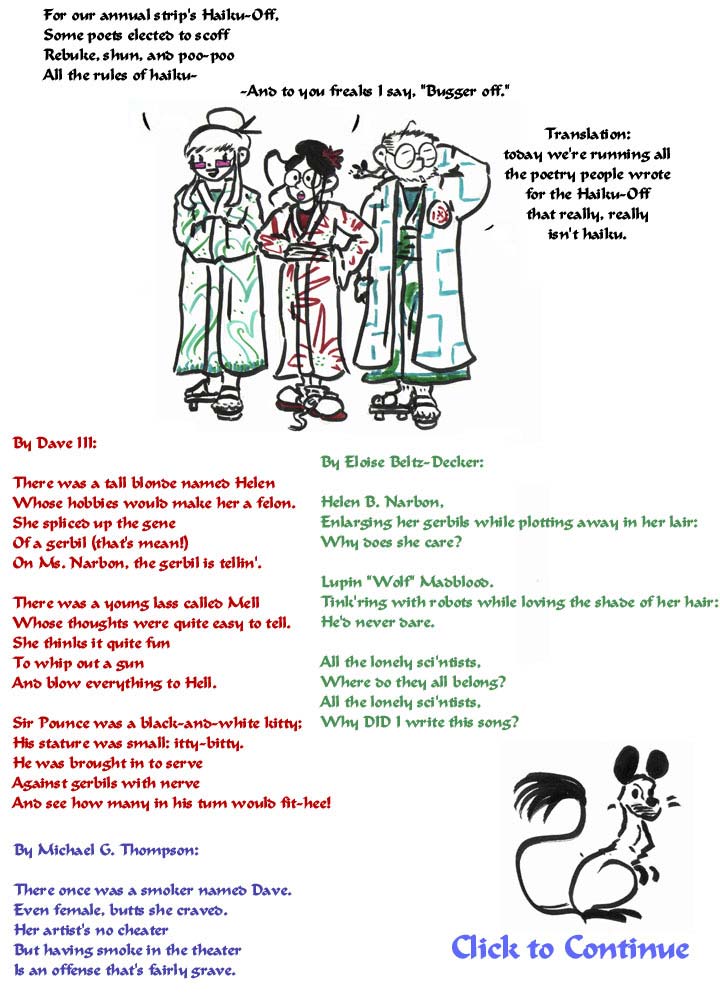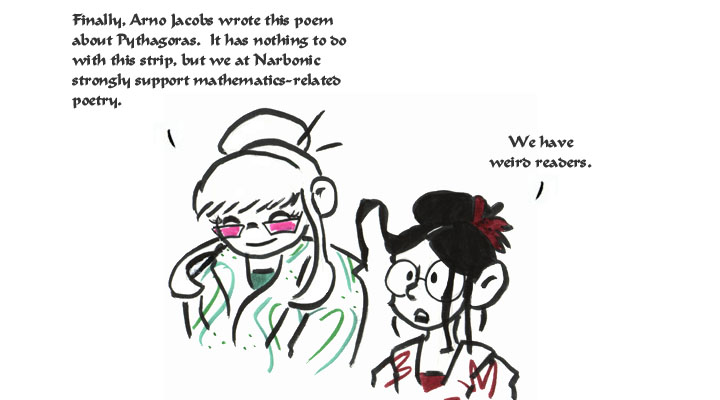Non-Haiku Runoff of the Haiku-Off
Commentary: On
July 6, 2008 ~ 6 Comments

You know what’s better than a feature that fills a Sunday for me? A feature that fills two Sundays for me! These brush-pen illustrations of the characters were pretty fun to do, incidentally, although I’m generally hopeless with brushes.

Well, it is a pretty cool math poem.
Personally, I was hoping the poem would be about the tale of Pythagoras murdering someone over the square root of 2 – an ancient case of Evil Mathematics if there ever was one. But a visual demonstration of his Theorem is fine anyways.
O beautiful for triangles
With angle right and true!
Your sides are squared; their sum becomes
The squared hypotenuse!
Pythagoras! Pythagoras!
Athena made thee smart!
‘Til Roman troops came marching in
To stab you in the heart!
But where /is/ the poem? Is it what Eddurd just posted? Because what Eddurd just posted is in fact awesome.
Except that the Greek mathematician killed by Roman soldiers was Archimedes.
Poem is at http://www.webcomicsnation.com/shaenongarrity/narbonic/series.php?view=archive&chapter=9908&mpe=1&fromwhich=1&direction=f
Hm, let me try to repost the poem from that link to get everything on the same page here.
To prove Pythagoras’ theorem would be easy to do:
You need a, b and c and some Greek letters too.
You see Pytha’ was a Greek, with a strange disposition:
based an entire math-based cult on a wrong supposition.
Yet this theorem bears his name: misplaced credit it may be,
It is named after a man who thought beans unhealty.
Though the proof requires squares, we shall need a triangle,
One that is blessed with a straight ninety degree angle.
For the shortest of the sides, the letters a and b we’ll use,
While the last letter c marks the hypothenuse.
We shall employ alpha and beta to name the angles not straight-
It won’t matter which goes where- you will see if you wait.
A squared plus b squared equals c squared, we shall show,
So the proof will employ a few squares, don’t you know.
But first, I have to tell, we need not one triangle but more,
All exactly the same; we shall need at least four.
Now that we have what we need, you might need pen and paper,
For from here on will start the great Pythagorasian caper.
As we’ve all learned back at school, it is basic math to see,
That the sum of alpha and beta is exactly ninety.
Place corner alpha of one triangle against corner beta of another;
It is hard to envision, but well worth the bother.
Now we repeat the process with the other triangles to see
That they’ve curled back into each other into a square with sides c!
Now the surface of this square, with basic math you can see,
That it equals c squared, that is, c multiplied by c.
But this is not all, for as you may recall,
This square is actually formed by four triangles and all.
Four triangles, but that’s not all, for in the largest square’s center,
We find we must allow a smaller square to enter.
This square, it is there, because the triangles, you see,
Were too small to cover the surface of square c.
Let us say the the shortest side was assigned letter a,
Then the sides of this square equal b minus a.
The surface of this square, much fun this will be,
Thus equals a squared plus b squared minus two times ab.
But wait, what of the triangles, four in number they be?
Well, their surface (basic math!) proves to be a half a times b.
But don’t forget there were four, or things will go amiss!
So if we seek their collective surface, then 2ab it is.
Now we add the inner square, cross some 2ab’s out,
And we will find the outer square’s surface, of that there’s no doubt.
What is this? A squared plus b squared, is that what we find?
Our previous answer c squared comes to mind.
One conclusion can be drawn, and that is that it’s no ruse,
The sum of the squares of the other sides equals the square of the hypothenuse!
Now smile and nod at the scary geek and tell him that you get it,
For if you don’t, and ask for more, you WILL live to regret it.